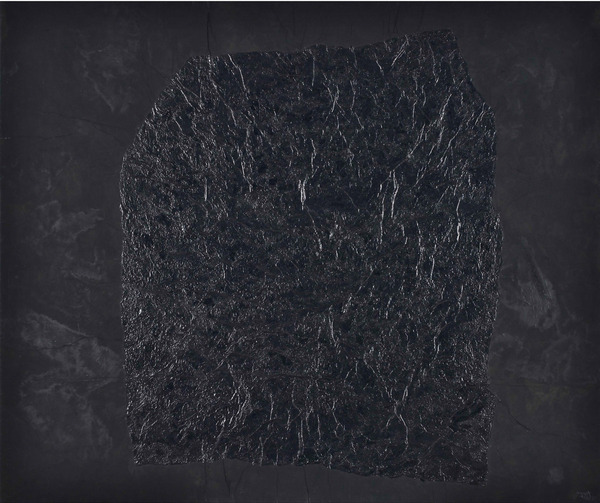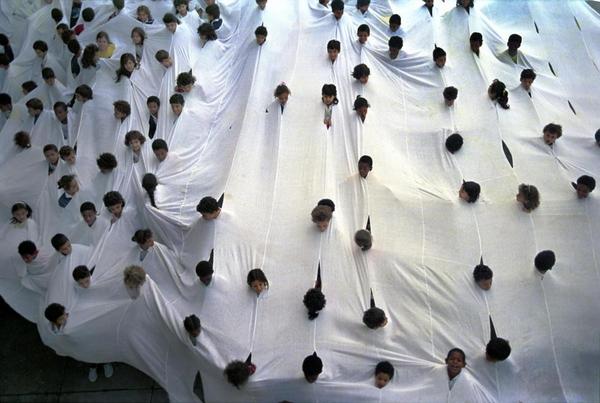The art fair in Hong Kong, now falling under the Art Basel umbrella, has succeeded for a number of reasons, perhaps chief among them the transparent market infrastructure of the city and the reputation for pragmatic mercantilism it has accumulated as a British entrepot. But as much as the rule of law has encouraged an internationally viable market structure, it has also made Hong Kong a rare hub for scholarship, particularly of the Anglophone variety, for much of Asia. Long before the launch of ArtHK and the establishment of a commercial gallery market, Hong Kong was home to non-profit and largely discursive institutions like Para-Site Art Space and Asia Art Archive. Both of these streams exist in parallel, and both are quite unique in greater China. The city might lag behind Beijing and Shanghai in terms of the artist population and facilities as centers for production, but, when it comes to exhibiting, selling, and interpreting art, Hong Kong is now the prime site.
Sitting, as I write, in the inaugural Hong Kong panel of the Art Basel Conversations—and, in fact, the first ever official Art Basel event in the city, I am reminded by Philip Tinari of the role late art writer and general art world connector Jonathan Napack played in bringing the fair to Asia. Napack occupied a fascinating niche in terms of balancing these scholarly and commercial aspects of the art scene, and clearly recognized that the market system of galleries, collections, and fairs would ultimately encourage a culture of conversation and critique that was sorely lacking just a decade ago. Although he passed away too early in 2007, Napack would have been gratified by the way this holistic ecology has begun to come together with Hong Kong as its center.

Adrian Wong, A Stain on the Stationer’s Linoleum, 2012, MDF, laminate, mosaic tiles, grout, latex rubber, enamel, 25.625 x 25.625 x 8 inches; Courtesy Rhona Hoffman Gallery, Hall1: 1B10.
As many publications are now running their previews of the art objects exhibited at the fair proper and projects installed at the galleries and alternative spaces around town, it is important to also recall the conversations moving along in parallel and, indeed, shaping the culture of commercial exhibitions in the region. The official series of panels, Art Basel Conversations, connects Hong Kong with a network of similar events in Switzerland and Miami; this series launched first with a discussion between locally based artists Adrian Wong, Chow Chun Fai, Ho Sin Tung, and Linda Lai. Further iterations over the course of the week will stage a dialogue between gallerist Leng Lin and artist Zhang Xiaogang; a discussion about museum architecture in Asia; and thoughts from leading regional collectors Alan Lau and Dick Quan.
Then there is the Asia Art Archive, which has determined to continue the parallel program it provided as the official partner of ArtHK prior to the entry of the fair into the Art Basel family. Entitled "Unpacking Global," the conference this year still brings some of the biggest historically-minded highlights to the Hong Kong scene, including the Burger Collection Keynote delivered by the critic and curator Geeta Kapur, author of the seminal book When was Modernism: Essays on Contemporary Cultural Practice in India. Elsewhere, critic Joan Kee moderates a panel on the lives of abstraction in Asia.
Asia Art Archive is also using a booth space in the art fair to host a radically less formal initiative called "Open Platform," which moves into its more intimate setting this year from a position within the broader conference in prior iterations. Following an open call for proposals, the Archive team has coordinated a series of meetings between professionals and other practitioners; the focus is on conversational exchange between those invited to meet, but, because of the location of the project within the art fair environment, visitors are invited to gather around and partake in a more performative sense of listening. Highlights include critic Lee Weng Choy on "Comparative Contemporary," AAA founder Claire Hsu and Chantal Wong on "Mapping Asia" and the journal "Field Notes," and Ann Demeester hosting the De Appel's new Gallerist Program.

Yang Jiechang,100 Layers of Ink, 1995, Chinese ink on Xuan paper on gauze, 98 x 118 cm, 38 1/2 x 46 1/2 inches; Courtesy Alisan Fine Arts, Hall 3: 3C32.
Moving away from the contemporary, the Asia Society will also host a range of panel discussions. A curatorial conversation with historians Jane DeBevoise and Kuiyi Shen will introduce the current exhibition, a brilliant look at unofficial art in China during the decade between the Cultural Revolution and the 85 New Wave entitled "Light before Dawn." In a similarly heritage-oriented vein, historian Britta Erickson and artist Yang Jiechang look at the place of ink in contemporary practice. Later, representatives of the Guggenheim, Robert N. Ho Foundation, and Asia Society discuss the stakes of institutional partnership in Asia today. Rounding out the week, artist Nadim Abbas, collector Uli Sigg, and curator Daniel Kurjakovic evaluate the evolving cultural ecology of Hong Kong--an important question that deserves precisely this kind of fluid, balanced, and international approach.
And of course, the conversational highlight of any Hong Kong art week must be the annual Intelligence Squared debate. This year the topic is, appropriately enough for the topic of this preview, "The Market is the Best Judge of Art's Quality." As a live event, the debate adopts the format of the "Artforum" sandwich: publisher Charles Guarino moderates, advertiser Jeffrey Deitch speaks on behalf of the motion, and frequent topic of critical praise Rirkrit Tiravanija offers a position of spirited opposition. No one ever wins, whatever Guarino will end up deciding.
Panels and lectures are not, however, the only mechanisms of immateriality in terms of the art experience, of course. Twice this week Para-Site curators Cosmin Costinas and Inti Guerrero will orchestrate large-scale participatory performances originating with Latin American conceptualist Lygia Pape. Patrons Yana and Stephen Peel, infamous for putting together the last big blowout of the fair week, this year have invited Kalup Linzy, who will perform in a range of bar spaces designed by local watering holes, all on the deck of the floating Jumbo barge in Aberdeen Harbor.

Lygia Pape, Divisor, 1968; courtesy Para-Site Art Space.
And there is the crowning glory of Art Basel in Hong Kong 2013: Adrian Wong's art bar installation for the Absolut Art Bureau, Wun Dun. In terms of performance, the artist has hired a group of Cantonese opera and lounge singers to interact with an animatronic jazz duo, which will be augmented by live sound and DJ performances by Christiaan Virant, one-half of the sound art duo FM3 and inventor of the Buddha Machine, and Alok Leung, the keystone of the local indie scene and a musical force of nature backed up by crates of vintage Asian porn soundtracks on vinyl.
From history to performance, Hong Kong offers a spectrum of positions and events beyond the much-lauded works on view at Art Basel and in the galleries this week; the future of art in the city depends on maintaining this balance within and beyond the market.
(Image at top: Chen Qiulin, The Garden No.2, 2007, Photograph, 124 × 152 cm, Ed.8; Courtesy A Thousand Plateaus Art Space, Hall 3: 3D13.)